User Manual
This User Manual is designed to help you become familiar with WEST
SYSTEM products and how they are used. It provides information about safe handling and the
basic techniques of epoxy use. Understanding these basic techniques will allow you to
tailor WEST SYSTEM products to your exact repair and construction needs. These techniques
are used in a wide range of repair and building procedures such as those described in
detail in WEST SYSTEM instructional
publications and videos.
The Product Guide section gives you complete descriptions of WEST SYSTEM products, including
selection and coverage guides to help you choose the most appropriate products and product
sizes for your project.
HANDLING
EPOXY
This section explains the fundamentals of epoxy curing and
the steps for proper dispensing, mixing, and adding fillers to assure that every batch of
epoxy cures to a useful high-strength solid.
Epoxies are safe when handled properly. To use WEST SYSTEM
epoxies safely, you must understand their hazards and take precautions to avoid them.
Hazards
The primary hazard associated with epoxy involves skin
contact. WEST SYSTEM Resins may cause moderate skin irritation. WEST SYSTEM Hardeners are
corrosive and may cause severe skin irritation. Resins and hardeners are also sensitizers
and may cause an allergic reaction similar to poison ivy. Susceptibility and the severity
of a reaction varies with the individual. Although most people are not sensitive to WEST
SYSTEM Resins and Hardeners, the risk of becoming sensitized increases with repeated
contact. For those who become sensitized, the severity of the reaction may increase with
each contact. These hazards also apply to the sanding dust from epoxy that has not fully
cured. These hazards decrease as resin/hardener mixtures reach full cure. Refer to product
labels or Material Safety Data Sheets for specific product warnings and safety
information.
Precautions
- Avoid contact with resin, hardeners, mixed epoxy and sanding
dust from epoxy that is not fully cured. Wear protective gloves and clothing whenever you
handle WEST SYSTEM Epoxies. Barrier skin creams provide additional protection. If you do
get resin, hardener or mixed epoxy on your skin, remove it as soon as possible. Resin is
not water soluble—use a waterless skin cleanser to remove resin or mixed epoxy from
your skin. Hardener is water soluble—wash with soap and warm water to remove hardener
or sanding dust from your skin. Always wash thoroughly with soap and warm water after
using epoxy. Never use solvents to remove epoxy from your skin.
Stop using the product if you develop a reaction. Resume
work only after the symptoms disappear, usually after several days. When you resume work,
improve your safety precautions to prevent exposure to epoxy, its vapors and sanding dust.
If problems persist, discontinue use and consult a physician.
- Protect your eyes from contact with resin, hardeners, mixed
epoxy, and sanding dust by wearing appropriate eye protection. If contact occurs,
immediately flush the eyes with water under low pressure for 15 minutes. If discomfort
persists, seek medical attention.
- Avoid breathing concentrated vapors and sanding dust. WEST
SYSTEM epoxies have low VOC content, but vapors can build up in unvented spaces. Provide
ample ventilation when working with epoxy in confined spaces, such as boat interiors. When
adequate ventilation is not possible, wear a NIOSH (National Institute for Occupational
Safety and Health) approved respirator with an organic vapor cartridge. Provide
ventilation and wear a dust mask when sanding epoxy, especially partially cured epoxy.
Breathing partially cured epoxy dust increases your risk of sensitization. Although epoxy
cures quickly to a sandable solid, it may take over two weeks at room temperature, or
elevated temperature post-curing, to cure completely.
- Avoid ingestion. Wash thoroughly after handling epoxy,
especially before eating. If epoxy is swallowed, drink large quantities of water DO NOT
induce vomiting. Because hardeners are corrosive, they can cause additional harm if
vomited. Call a physician immediately. Refer to First Aid procedures on the Material
Safety Data Sheet.
KEEP RESINS, HARDENERS, FILLERS AND SOLVENTS OUT OF THE
REACH OF CHILDREN.
For additional safety information or data, write to: EPOXY SAFETY, Gougeon Brothers, Inc.,
P.O. Box 908, Bay City, MI 48707 USA
Contain large spills with sand, clay or other inert
absorbent material. Use a scraper to contain small spills and collect as much material as
possible. Follow up with absorbent towels. Uncontaminated resin or hardener may be
reclaimed for use.
DO NOT use sawdust or other fine cellulose materials to
absorb hardeners.
DO NOT dispose of hardener in trash containing sawdust or
other fine cellulose materials—spontaneous combustion can occur.
Clean resin or mixed epoxy residue with lacquer
thinner, acetone or alcohol. Follow all safety warnings on solvent containers. Clean
hardener residue with warm soapy water.
Dispose of resin, hardener and empty containers
safely. Puncture a corner of the can and drain residue into the appropriate new container
of resin or hardener.
DO NOT dispose of resin or hardener in a liquid state.
Waste resin and hardener can be mixed and cured (in small quantities) to a non-hazardous
inert solid.
CAUTION! Large pots of curing epoxy can get hot enough to
ignite surrounding combustible materials and give off hazardous fumes. Place pots of mixed
epoxy in a safe and ventilated area, away from workers and combustible materials. Dispose
of the solid mass only if cure is complete and the mass has cooled. Follow federal, state
or local disposal regulations.
Epoxy's cure stages
Mixing epoxy resin and hardener begins a chemical reaction
that transforms the combined liquid ingredients to a solid. The time it takes for this
transformation is the cure time. As it cures, the epoxy passes from the liquid
state, through a gel state, before it reaches a solid state (Figure 1).
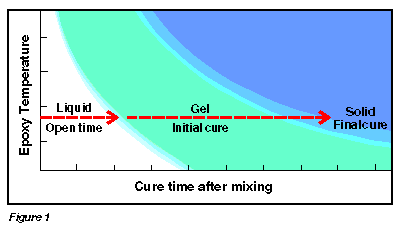 1. Liquid—Open time
1. Liquid—Open time
Open time (also working time or wet lay-up time) is the
portion of the cure time, after mixing, that the resin/hardener mixture remains a liquid
and is workable and suitable for application. All assembly and clamping should take place
during the open time to assure a dependable bond.
2. Gel—Initial cure
The mixture passes into an initial cure phase (also called
the green stage) when it begins to gel or "kick-off." The epoxy is no
longer workable and will no longer feel tacky. During this do not disturb stage it
progresses from a soft gel consistency to the firmness of hard rubber. You will be able to
dent it with your thumb nail.
Because the mixture is only partially cured, a new
application of epoxy will still chemically link with it, so the surface may still be
bonded to or recoated without special preparation. However, this ability diminishes
as the mixture approaches final cure.
Solid—Final cure
The epoxy mixture has cured to a solid state and can
be dry sanded and shaped. You should not be able to dent it with your thumbnail. At this
point the epoxy has reached about 90% of its ultimate strength, so clamps can be removed.
It will continue to cure over the next several days at room temperature.
A new application of epoxy will no longer chemically link
to it, so the surface of the epoxy must be properly prepared and sanded before
recoating to achieve a good mechanical, secondary bond. See Surface
Preparation
Understanding cure time
Open time and cure time govern much of the activity of
building and repairing with epoxy. Open time dictates the time available for mixing,
application, smoothing, shaping, assembly and clamping. Cure time dictates how long you
must wait before removing clamps, or before you can sand or go on to the next step in the
project. Two factors determine an epoxy mixture’s open time and overall cure
time—hardener cure speed and epoxy temperature.
Hardener speed
Each hardener has an ideal temperature cure range. At any given temperature, each
resin/hardener combination will go through the same cure stages, but at different rates.
Select the hardener that gives you adequate working time for the job you are doing at the
temperature and conditions you are working under. The product guide and container labels
describe hardener pot lives and cure times.
Pot life is a term used to compare the cure speeds of
different hardeners. It is the amount of time a specific mass of mixed resin and hardener
remains a liquid at a specific temperature. (A 100g-mass mixture in a standard container,
at 72°F). Because pot life is a measure of the cure speed of a specific contained mass
(volume) of epoxy rather than a thin film, a hardener’s pot life is much shorter than
its open time.
Epoxy temperature
The warmer the temperature of curing epoxy, the faster it
cures (Figure 1). The temperature of curing epoxy is determined by the ambient
temperature plus the exothermic heat generated by its cure.
Ambient temperature is the temperature of the air or
material in contact with the epoxy. Air temperature is most often the ambient temperature
unless the epoxy is applied to a surface with a different temperature. Generally, epoxy
cures faster when the air temperature is warmer.
Exothermic heat is produced by the chemical reaction
that cures epoxy. The amount of heat produced depends on the thickness or exposed surface
area of mixed epoxy. In a thicker mass, more heat is retained, causing a faster reaction
and more heat. The mixing container’s shape and the mixed quantity have a great
affect on this exothermic reaction. A contained mass of curing epoxy (8 fl. oz. or more)
in a plastic mixing cup can quickly generate enough heat to melt the cup and burn your
skin. However, if the same quantity is spread into a thin layer, exothermic heat is
dissipated, and the epoxy's cure time is determined by the ambient temperature. The
thinner the layer of curing epoxy, the less it is affected by exothermic heat, and the
slower it cures.
Controlling cure time
In warm conditions use a slower hardener, if possible.
Mix smaller batches that can be used up quickly, or pour the epoxy mixture into a
container with greater surface area (a roller pan, for example), thereby allowing
exothermic heat to dissipate and extending open time. The sooner the mixture is
transferred or applied (after thorough mixing), the more of the mixture’s useful open
time will be available for coating, lay-up or assembly.
In cool conditions use a faster hardener, or use
supplemental heat to raise the epoxy temperature above the hardener’s minimum
recommended application temperature. Use a hot air gun, heat lamp or other heat source to
warm the resin and hardener before mixing or after the epoxy is applied. At room
temperature, supplemental heat is useful when a quicker cure is desired.
CAUTION! Heating epoxy that has not gelled will
lower its viscosity, allowing the epoxy to run or sag more easily on vertical surfaces. In
addition, heating epoxy applied to a porous substrate (soft wood or low density core
material) may cause the substrate to "out-gas" and form bubbles in the epoxy
coating. To avoid out-gassing, wait until the epoxy coating has gelled before warming it.
Never heat mixed epoxy in a liquid state over 120°F (49°C).
Regardless of what steps are taken to control the cure
time, thorough planning of the application and assembly will allow you to make maximum use
of epoxy's open time and cure time.
Careful measuring of epoxy resin and hardener and thorough
mixing are essential for a proper cure. 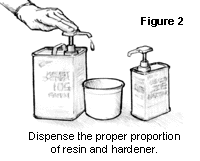 Whether the
resin/hardener mixture is applied as a coating or modified with fillers or additives,
observing the following procedures will assure a controlled and thorough chemical
transition to a high-strength epoxy solid.
Whether the
resin/hardener mixture is applied as a coating or modified with fillers or additives,
observing the following procedures will assure a controlled and thorough chemical
transition to a high-strength epoxy solid.
Dispensing
Dispense the proper proportions of resin and hardener into
a clean plastic, metal or wax-free paper container (Figure 2). Don’t use glass
or foam containers because of the potential danger from exothermic heat build-up.
DO NOT attempt to adjust the epoxy cure time by altering
the mix ratio. An accurate ratio is essential for a proper cure and full development of
physical properties.
- Dispensing with Mini pumps—
Most problems related to
curing of the epoxy can be traced to the wrong ratio of resin and hardener. To simplify
metering, we recommend using calibrated WEST SYSTEM Mini Pumps to dispense the resin and
hardener. 301 Mini Pumps and 303 Special Ratio Mini Pumps are calibrated to deliver the
proper working ratio of resin to hardener.
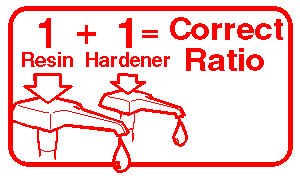 Pump one full pump stroke of
resin for each one full pump stroke of hardener. Depress each pump head fully and
allow the head to come completely back to the top before beginning the next stroke.
Partial strokes will give the wrong ratio. Read the pump instructions before using pumps.
Pump one full pump stroke of
resin for each one full pump stroke of hardener. Depress each pump head fully and
allow the head to come completely back to the top before beginning the next stroke.
Partial strokes will give the wrong ratio. Read the pump instructions before using pumps.
Before you use the first mixture on a project, verify the
proper ratio according to the instructions that come with the pumps. Re-check the ratio
anytime you experience problems with curing.
- Dispensing without Mini Pumps
(Weight/volume
measure)—To measure 105 Resin and 205 or 206 Hardener by weight or volume, combine
five parts resin with one part hardener. To measure 105 Resin and 207 or 209 Hardener by
volume, combine three parts resin with one part hardener (by weight, 3.5 parts
resin–1 part hardener).
First time users
If this is the first time you have used WEST SYSTEM epoxy,
begin with a small test batch to get the feel for the mixing and curing process, before
applying the mixture to your project. This will demonstrate the hardener's open time for
the temperature you are working in and assure you that the resin/hardener ratio is metered
properly. Mix small batches until you are confident of the mixture's handling
characteristics.
Mixing
Stir the two ingredients together thoroughly—at least
1 minute—longer in cooler temperatures (Figure 3). 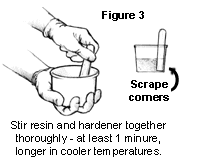 To assure
thorough mixing, scrape the sides and bottom of the pot as you mix. Use the flat end of
the mixing stick to reach the inside corner of the pot. If you are using a power mixer,
occasionally scrape the sides and corners of the mixing pot while mixing.
To assure
thorough mixing, scrape the sides and bottom of the pot as you mix. Use the flat end of
the mixing stick to reach the inside corner of the pot. If you are using a power mixer,
occasionally scrape the sides and corners of the mixing pot while mixing.
If you are going to be using the mixture for coating,
quickly pour it into a roller pan to extend the open time.
WARNING! Curing epoxy generates heat. When
contained, a large mass of curing epoxy has a very short pot life, and can generate enough
heat to melt plastic and foam, burn your skin and ignite combustible materials. For this
reason do not use foam or glass mixing containers. If a pot of mixed epoxy begins to
exotherm (heat up), quickly move it outdoors. Avoid breathing the fumes. Do not dispose of
the mixture until the reaction is complete and has cooled. Do not fill or cast layers of
epoxy thicker than 1/2"—thinner if enclosed by foam or other insulating
material. Do not pour into confined spaces.
Fillers
Throughout this and other WEST SYSTEM manuals, we refer to epoxy,
neat epoxy or resin/hardener mixture, meaning mixed resin and hardener without
fillers added; and thickened mixture or thickened epoxy, meaning mixed resin
and hardener with fillers added. Fillers are used to thicken epoxy for specific
applications such as bonding or fairing.
After selecting an appropriate filler for your job (see
Filler selection guide), use it to thicken the epoxy mixture to the desired
consistency. The thickness of a mixture required for a particular job is controlled by the
amount of filler added. There is no strict formula or measuring involved—use your eye
to judge what consistency will work best. Figure 5 gives you a general guide to the
differences between neat (unthickened) epoxy and the three consistencies referred to in
this manual.
Always add fillers in a two-step process:
- Mix the desired quantity of resin and hardener thoroughly
before adding fillers. Begin with a small batch—allow room for the filler.
- Blend in small handfuls or scoops of the appropriate filler
until the desired consistency is reached (Figure 4).
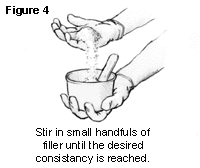 For maximum strength, add only enough filler to completely bridge
gaps between surface without sagging or running out of the joint or gap. A small amount
should squeeze out of joints when clamped. For thick mixtures, don't fill the mixing cup
more than 1/3 full of epoxy before adding filler. When making fairing compounds, stir in
as much 407 or 410 as you can blend in smoothly—for easy sanding, the thicker the
better. Be sure all of the filler is thoroughly blended before the mixture is applied.
For maximum strength, add only enough filler to completely bridge
gaps between surface without sagging or running out of the joint or gap. A small amount
should squeeze out of joints when clamped. For thick mixtures, don't fill the mixing cup
more than 1/3 full of epoxy before adding filler. When making fairing compounds, stir in
as much 407 or 410 as you can blend in smoothly—for easy sanding, the thicker the
better. Be sure all of the filler is thoroughly blended before the mixture is applied.
Spread the mixture into a thinner layer, either around the
inside of the mixing cup or onto a flat non-porous surface or palette, to extend its
working life.
Epoxy can be
thickened to the ideal consistency needed for a particular job. The procedures in this
manual refer to four common consistencies: syrup, catsup, mayonnaise and peanut butter.
|
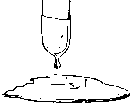 |
SYRUP CONSISTENCY: Unthickened mixture
CHARACTERISTICS: Drips off vertical surfaces.
USES: Coating; wetting-out before bonding; applying fiberglass, graphite and other
fabrics.
|
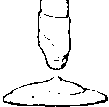 |
CATSUP CONSISTENCY: Slightly thickened
CHARACTERISTICS: Sags down vertical surfaces.
USES: Laminating/bonding flat panels with large surface areas, injecting with a syringe.
|
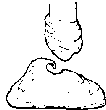 |
MAYONNAISE CONSISTENCY: Moderately thickened
CHARACTERISTICS: Clings to vertical surfaces; peaks fall over.
USES: General bonding, filleting, hardware bonding
|
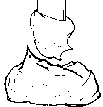 |
PEANUT BUTTER CONSISTENCY: Maximum thickness
CHARACTERISTICS: Clings to vertical surfaces; peaks stand up.
USES: Gap filling, filleting, fairing, bonding uneven surfaces.
|
Additives
Additives are used to give epoxy additional physical
properties when used as a coating. Although additives are blended with mixed epoxy in the
same two-step process as fillers, they are not designed to thicken the epoxy.
Follow the mixing instructions on the individual additive containers.
BASIC
TECHNIQUES
The following basic techniques are common to most repair or
building projects, regardless of the type of structure or material you are working with.
Whether you are bonding, fairing or applying fabrics, the
success of the application depends not only on the strength of the epoxy, but also on how
well the epoxy adheres to the surface to which it is being applied. Unless you are bonding
to partially cured epoxy, the strength of the bond relies on the epoxy’s ability to
mechanically "key" into the surface. That is why the following three steps of
surface preparation are a critical part of any secondary bonding operation.
For good adhesion, bonding surfaces should be:
1. Clean Bonding surfaces must be free of any
contaminants such as grease, oil, wax or mold release. Clean contaminated surfaces with
lacquer thinner, acetone or other appropriate solvent. Wipe the surface with paper towels
before the solvent dries. Clean surfaces before sanding to avoid sanding the
contaminant into the surface. Follow all safety precautions when working with solvents. (Figure
6)
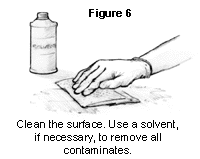
2. Dry All bonding surfaces must be as dry as possible
for good adhesion. If necessary, accelerate drying by warming the bonding surface with a
hot air gun, hair dryer or heat lamp. Use fans to move the air in confined or enclosed
spaces. Watch for condensation when working outdoors or whenever the temperature of the
work environment changes. (Figure 7)
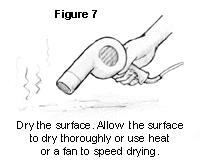
3. Sanded Sand smooth non-porous
surfaces—thoroughly abrade the surface. 80-grit aluminum oxide paper will provide a
good texture for the epoxy to "key" into. Be sure the surface to be bonded is
solid. Remove any flaking, chalking, blistering, or old coating before sanding. Remove all
dust after sanding. (Figure 8)
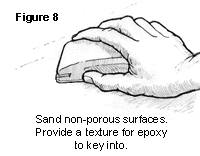
Special
preparation for various materials
Cured epoxy—Amine blush can appear as a
wax-like film on cured epoxy surfaces. It is a by-product of the curing process and may be
more noticeable in cool, moist conditions. Amine blush can clog sandpaper and inhibit
subsequent bonding, but it can easily be removed. It’s a good idea to assume it has
formed on any cured epoxy surface.
To remove the blush, wash the surface with clean water (not
solvent) and an abrasive pad, such as Scotch-brite™ 7447 General Purpose Hand Pads.
Dry the surface with paper towels to remove the dissolved blush before it dries on the
surface. Sand any remaining glossy areas with 80-grit sandpaper. Wet-sanding will also
remove the amine blush. If a release fabric is applied over the surface of fresh epoxy,
amine blush will be removed when the release fabric is peeled from the cured epoxy and no
additional sanding is required.
Epoxy surfaces that have not fully cured may be bonded to
or coated with epoxy without washing or sanding. Before applying coatings other
than epoxy (paints, bottom paints, varnishes, gelcoats, etc.), allow epoxy surfaces to
cure fully, then wash and sand.
Hardwoods—Sand with 80-grit paper
Teak/oily woods—Wipe with acetone 15 minutes
before coating. Solvent removes the oil at the surface and allows epoxy to penetrate. Be
sure solvent has evaporated before coating.
Porous woods—No special preparation needed. If
surface is burnished, possibly by dull planer or saw blades, sand with 80-grit paper to
open pores. Remove dust.
Steel, lead—Remove contamination, sand or grind
to bright metal, coat with epoxy then sand fresh epoxy into surface. Re-coat or bond after
first coat gels.
Aluminum—Sand and prepare with 860 Aluminum
Etch Kit.
Polyester (fiberglass)—Clean contamination with
a silicone and wax remover such as DuPont Prep-Sol™ 3919S. Sand with 80-grit paper to
a dull finish.
Plastic—Adhesion varies. If a plastic is
impervious to solvents such as acetone, epoxy generally will not bond to it. Soft,
flexible plastics such as polyethylene, polypropylene, nylon, Plexiglas and polycarbonate
fall into this category.
Hard, rigid plastics such as PVC, ABS and styrene provide
better adhesion with good surface preparation and adequate bonding area. After sanding,
flame oxidizing (by quickly passing propane torch over the surface without melting the
plastic) can improve bonding in some plastics. It’s a good idea to conduct an
adhesion test on a plastic that you are uncertain about.
This section refers to two types of bonding. Two-step
bonding is the preferred method for most situations because it promotes maximum epoxy
penetration into the bonding surface and prevents resin-starved joints. Single-step
bonding can be used when joints have minimal loads and excess absorption into porous
surfaces is not a problem. In both cases, epoxy bonds best when it is worked into the
surface with a roller or brush.
Before mixing epoxy, check all parts to be bonded for
proper fit and surface preparation, gather all the clamps and tools
necessary for the operation, and cover any areas that need protection from spills.
Note: The term bonding as used here and other WEST SYSTEM
literature
Refers to structural adhesion or gluing of components, not
the electrical bonding
Two-step bonding
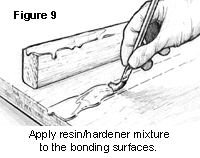 |
- Wet-out bonding surfaces—Apply a neat resin/hardener
mixture (without fillers) to the surfaces to be joined (Figure 9). Wet out small or
tight areas with a disposable brush. Wet out larger areas with a foam roller or by
spreading the resin/hardener mixture evenly over the surface with a plastic spreader. You
may proceed with step two immediately or any time before the wet-out coat reaches the
final cure stage.
|
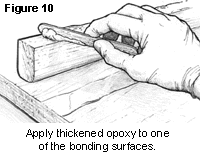 |
- Apply thickened epoxy to one bonding surface. Modify the
resin/hardener mixture by stirring in the appropriate filler until it becomes thick enough
to bridge any gaps between the mating surfaces and to prevent "resin-starved"
joints. Apply enough of the mixture to one of the surfaces, so that a small amount will
squeeze out when the surfaces are joined together with a force equivalent to a firm hand
grip (Figure 10).
Thickened epoxy can be applied immediately over the wet-out surface or any time before the
wet-out reaches its final cure. For most small bonding operations, add the filler to the
resin/hardener mixture remaining in the batch that was used for the wet-out. Mix enough
resin/hardener for both steps. Add the filler quickly after the surface is wet out and
allow for a shorter working life of the mixture.
|
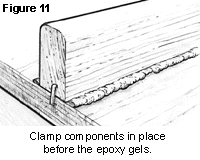 |
- Clamp components. Attach clamps as necessary to hold the
components in place. Use just enough clamping pressure to squeeze a small amount of the
epoxy mixture from the joint, indicating that the epoxy is making good contact with both
mating surfaces (Figure 11). Avoid using too much clamping pressure, which can
squeeze all of the epoxy mixture out of the joint.
|
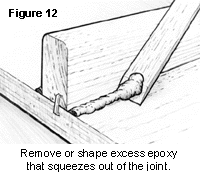 |
- Remove or shape excess adhesive that squeezes out of the
joint as soon as the joint is secured with clamps. A wooden mixing stick with one end
sanded to a chisel edge is an ideal tool for removing the excess (Figure 12).
|
Single-step bonding
Single-step bonding is applying the thickened epoxy
directly to both bonding surfaces without first wetting out the surfaces with neat
resin/hardener. We recommend that you thicken the epoxy no more than is necessary to
bridge gaps in the joint (the thinner the mixture, the more it can penetrate the surface)
and that you do not use this method for highly-loaded joints or for bonding end grain or
other porous surfaces.
Laminating
The term "laminating" refers to the process of
bonding numbers of relatively thin layers, like plywood, veneers, fabrics or core material
to create a composite. A composite may be any number of layers of the same material or
combinations of different materials. Methods of epoxy application and clamping will differ
depending on what you are laminating.
Because of large surface areas and limitations of wet
lay-up time, roller application is the most common method for applying epoxy. A faster
method for large surfaces is to simply pour the resin/hardener mixture onto the middle of
the panel and spread the mixture evenly over the surface with a plastic spreader. Apply
thickened mixtures with an 809 Notched Spreader.
Using staples or screws is the most common method of
clamping when you laminate a solid material to a solid substrate. An even distribution of
weights will work when you are laminating a solid material to a base that will not hold
staples or screws, such as a foam or honeycomb core material.
Vacuum bagging is the ideal clamping method for laminating
a wide range of materials. Through the use of a vacuum pump and plastic sheeting, the
atmosphere is used to apply perfectly even clamping pressure over all areas of a panel
regardless of the size, shape or number of layers.
Tips
Primary/Secondary Bonding
Primary bonding relies on the chemical linking of adhesive
layers such as the wet lay-up of fiberglass laminate in a mold. All the layers of adhesive
cure together in a single fused layer. Epoxy applied over partially cured epoxy will
chemically link with it and is a primary bond. The ability to chemically link diminishes
as the epoxy cures and it becomes a secondary bond.
Secondary bonding relies on the mechanical linking of an
adhesive to a material or cured epoxy surface. The adhesive must "key" into
pores or scratches in the surface—a microscopic version of a dovetail joint. Proper
surface preparation provides a texture that will help lock the cured epoxy to the surface.
Any method of clamping is suitable as long as the parts to
be joined are held so that movement will not occur. Common methods include spring clamps,
"C" clamps and adjustable bar clamps, heavy rubber bands cut from inner tubes,
nylon-reinforced packaging tape, applying weights, and vacuum bagging. When placing clamps
near epoxy-covered areas, cover clamp pads with duct tape, or use polyethylene sheeting or
release fabric under the clamps so they don’t inadvertently bond to the surface.
Staples, nails or drywall screws are often used where conventional clamps will not work.
Any fasteners left in should be of a non-corroding alloy such as bronze. In some cases the
thickened epoxy or gravity will hold parts in position without clamps.
A fillet (fil’it) is a cove-shaped application of
thickened epoxy that bridges an inside corner joint. It is excellent for bonding parts
because it increases the surface area of the bond and serves as a structural brace. All
joints that will be covered with fiberglass cloth will require a fillet to support the
cloth at the inside corner of the joint.
The procedure for bonding with fillets is the same as
normal bonding except that instead of removing the squeezed-out thickened epoxy after the
components are clamped in position, you shape it into a fillet. For larger fillets, add
thickened mixture to the joint as soon as the bonding operation is complete, before the
bonding mixture is fully cured, or any time after the final cure and sanding of exposed
epoxy in the fillet area.
- Bond parts as described in Bonding.
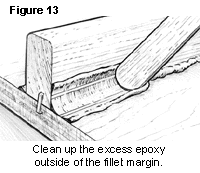 |
- Shape and smooth the squeezed-out thick epoxy into a fillet
by drawing a rounded filleting tool (mixing stick) along the joint, dragging excess
material ahead of the tool and leaving a smooth cove-shaped fillet bordered on each side
by a clean margin. Some excess filleting material will remain outside of the margin (Figure
13). Use the excess material to re-fill any voids. Smooth the fillet until you are
satisfied with its appearance. A mixing stick will leave a fillet with about a 3/8"
radius. For larger fillets, an 808 Plastic Squeegee, cut to shape or bent to the desired
radius, works well.
Apply additional thickened epoxy to fill voids or make
larger fillets. Apply the mixture along the joint line with the rounded mixing stick,
using enough mixture to create the desired size of fillet. For longer or multiple fillets,
empty caulking gun cartridges or disposable cake decorating bags can be used. Cut the
plastic tip to lay a bead of thickened epoxy large enough for the desired fillet size.
Heavy duty, sealable food storage bags with one corner cut off may also be used.
|
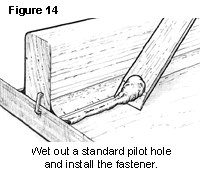 |
- Clean up the remaining excess material outside of the margin
by using a sharpened mixing stick or a putty knife (Figure 14). Fiberglass cloth or
tape may be applied over the fillet area before the fillet has cured (or after the fillet
is cured and sanded).
|
Sand smooth with 80-grit sandpaper after the fillet
has fully cured. Wipe the surface clean of any dust and apply several coats of
resin/hardener over the entire fillet area before final finishing.
Installing screws and other threaded fasteners with WEST
SYSTEM epoxy dramatically improves load carrying capacity by spreading the fastener’s
load into a greater area of the substrate. There are several methods or levels of hardware
bonding depending on the loads on the hardware.
Basic fastener bonding
For improved pullout strength and waterproof connections,
the easiest method is to simply wet out stripped fastener holes and new pilot holes before
installing the screws. Epoxy penetrates the fiber around the hole, effectively increasing
the fastener diameter. Epoxy also provides a stronger interface with the fastener threads
than wood fiber and keeps out water.
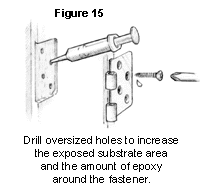
- Wet out a standard-size pilot hole. Work the mixture well
into the hole with a pipe cleaner or syringe (Figure 15). Thicken a second coat of
epoxy as necessary for stripped or oversized holes.
- Insert the fastener in the hole and allow the epoxy to cure.
Advanced fastener bonding
For greater strength and stability, drill oversized holes
to increase the exposed substrate area and the amount of epoxy around the fastener. If the
fastener/hardware can be clamped by other means, the oversized hole can be extended to the
end of the fastener.
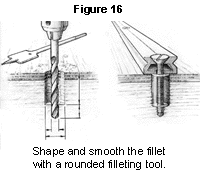
- Drill oversized holes 2/3–3/4 the depth of the
fastener. The diameter may be up to twice the fastener diameter (Figure 16a).
- Drill a normal sized pilot hole at the bottom of the
oversized hole to the full length of the fastener. The normal sized pilot hole serves to
hold or clamp the hardware in position until the epoxy cures.
- Wet out the holes and the fastener with epoxy. Allow the
epoxy to thoroughly soak into the exposed end grain of the wood.
- Fill the hole with thickened epoxy/adhesive filler. Use 404
High-density (preferred) or 406 Colloidal Silica.
- Install the fasteners with just enough force to hold the
hardware in place. Allow the epoxy to cure thoroughly before applying load to the hardware
(Figure 16b).
Bonding hardware
Bonding hardware goes a step beyond bonding the fasteners
only. By bonding the hardware base directly to the surface you further increase hardware
load capacity and provide a solid bearing surface for the hardware. It also seals the wood
underneath, and is a stronger, longer lasting attachment than bonding the fasteners only.
It is especially useful to mount hardware on curved, uneven or unlevel surfaces.
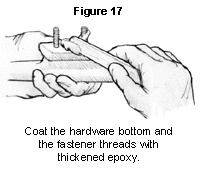
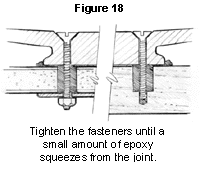
- Prepare the mounting surface and the hardware base for good
adhesion.
- Wet out the oversized hole with epoxy. Allow the epoxy to
soak into the exposed end grain of the wood (as with faster bonding).
- Coat the bottom contact surface of the hardware with
unthickened epoxy. Wire brush or sand the wet epoxy into the surface with 50-grit
sandpaper.
- Inject a non-sagging epoxy/404 or 406 mixture into the hole.
Use enough mixture so there are no voids in the hole after inserting the fastener. Coat
the bottom of the hardware and the fastener threads with thickened epoxy (Figure 17).
- Place the hardware in position. Insert and tighten fasteners
until a small amount of the mixture squeezes out of the joint (Figure 18).
- Remove excess epoxy or shape into a fillet. Allow the epoxy
to cure at least 24 hours before applying load to the hardware. Allow more time in cool
weather.
Casting a base
Use the thickened epoxy to cast a base under the hardware
when mounting hardware to a curved or uneven surface, or mounting hardware at an angle to
the surface.
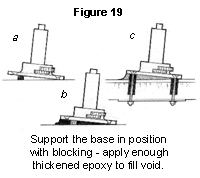
- Prepare the fasteners, holes, substrate and base as
described above.
- Bond small blocks to the substrate to support the base at
the desired height and position (e.g. winch base, Figure 19a)
- Apply enough thickened epoxy to cover the blocks. If the gap
between the base and the surface is over 1/2", fill the gap in two separate layers to
avoid exotherm.
- Place the hardware in position, resting on the blocks (Figure
19b) and install the fasteners.
- Smooth the excess epoxy into the desired fillet shape around
the base (Figure 19c). Allow the epoxy to cure fully before loading. Protect
exposed epoxy from UV.
Bonding studs
Bond threaded rods or studs into the substrate (instead of
bolts or screws) and attach the hardware with nuts. This variation is appropriate for many
engine, motor or machine installations. Coat the base with wax /mold release to make the
hardware removable. Although the hardware is not "bonded" to the substrate, the
epoxy still provides a bearing surface that perfectly matches and supports the base of the
hardware.
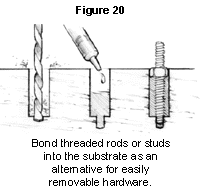
- Prepare the studs/threaded rods by waxing the upper ends
(above the surface) and cleaning the lower ends (below the surface).
- Place a nut and washer on the studs, wet out the lower ends
and push them into the epoxy filled holes. Allow the epoxy to cure thoroughly before
tightening the nuts (Figure 20).
Removing fasteners
If you know that you will want to remove the fastener, you
can coat the threads with wax or mold release (contaminating the surface enough to prevent
a good bond).
Remove a permanently bonded fastener by applying heat to
the head of the fastener with a soldering iron or propane torch. Use a heat shield to
protect the surrounding area. Heat will travel down the fastener, softening the epoxy in
contact with it. At about 120°F the epoxy should soften enough to allow the fastener to
be backed out. Allow more time for heat to travel down longer or larger diameter
fasteners.
Fairing refers to the filling and shaping of low areas so
they blend with the surrounding surfaces and appear "fair" to the eye and touch.
After major structural assembly has been completed, final fairing can be easily
accomplished with WEST SYSTEM epoxy and low-density fillers.
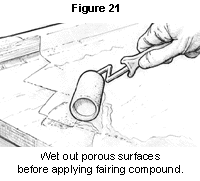
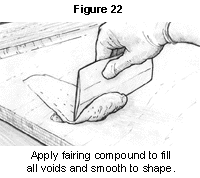
Prepare the surface as you would for
bonding. Sand smooth any bumps or ridges on the surface and remove all dust from the area
to be faired.
- Wet out porous surfaces with unthickened epoxy (Figure
21).
- Mix resin/hardener and 407 Low-Density or 410
Microlight™ filler to a peanut butter consistency. The thicker the mixture, the
easier it will be to sand when cured.
- Trowel on the thickened epoxy mixture with a plastic
squeegee, working it into all voids and depressions. Smooth the mixture to the desired
shape, leaving the mixture slightly higher than the surrounding area (Figure 22).
Remove any excess thickened epoxy before it cures. If the voids you are filling are over
1/2" deep, apply the mixture in several applications or use 206 Slow Hardener or 209
Tropical Hardener, depending on ambient temperature.
Note: On vertical and overhead surfaces, allow the wet-out
coat to gel before applying fairing compound. The fairing compound may sag or slide off
the fresh wet-out coat. Apply the fairing compound while the wet-out is still in the gel
stage.
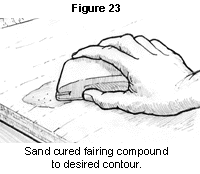
- Allow the final thickened epoxy application to cure
thoroughly.
- Sand the fairing material to blend with the surrounding
contour (Figure 23). Begin with 50-grit sandpaper if you have a lot of fairing
material to remove. Use 80-grit paper on the appropriate sanding block when you are close
to the final contour. CAUTION! Don’t forget your dust mask. Remove the sanding dust
and fill any remaining voids following the same procedure.
- Apply several coats of resin/hardener to the area with a
disposable brush or roller after you are satisfied with the fairness. Allow the final coat
to cure thoroughly before final sanding and finishing.
Fiberglass cloth is applied to surfaces to provide
reinforcement and/or abrasion resistance, or in the case of Douglas Fir plywood, to
prevent grain checking. It is usually applied after fairing and shaping are completed, and
before the final coating operation. It is also applied in multiple layers (laminated) and
in combination with other materials to build composite parts.
Fiberglass cloth may be applied to surfaces by either of
two methods. The "dry" method refers to applying the cloth over a dry surface.
The "wet" method refers to applying the cloth to an epoxy-coated surface often
after the wet-out coat becomes tacky, which helps it cling to vertical or overhead
surfaces. Since this method makes it more difficult to position the cloth, the dry method
is the preferred method especially with thinner cloth.
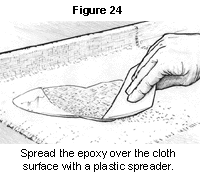
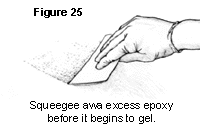
Dry method
Prepare the surface as you would for
bonding.
- Position the cloth over the surface and cut it several
inches larger on all sides. If the surface area you are covering is larger than the cloth
size, allow multiple pieces to overlap by approximately two inches. On sloped or vertical
surfaces, hold the cloth in place with masking or duct tape, or with staples.
- Mix a small quantity of epoxy (three or four pumps each of
resin and hardener).
- Pour a small pool of resin/hardener near the center of the
cloth.
- Spread the epoxy over the cloth surface with a plastic
spreader, working the epoxy gently from the pool into the dry areas (Figure 24).
Use a foam roller or brush to wet out fabric on vertical surfaces. Properly wet out fabric
is transparent. White areas indicate dry fabric. If you are applying the cloth over a
porous surface, be sure to leave enough epoxy to be absorbed by both the cloth and the
surface below it. Try to limit the amount of squeegeeing you do. The more you
"work" the wet surface, the more minute air bubbles are placed in suspension in
the epoxy. This is especially important if you plan to use a clear finish. You may
use a roller or brush to apply epoxy to horizontal as well as vertical surfaces.
Smooth wrinkles and position the cloth as you work your way
to the edges. Check for dry areas (especially over porous surfaces) and re-wet them as
necessary before proceeding to the next step. If you have to cut a pleat or notch in the
cloth to lay it flat on a compound curve or corner, make the cut with a pair of sharp
scissors and overlap the edges for now.
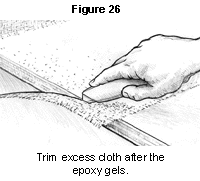
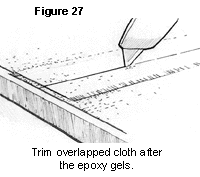
- Squeegee away excess epoxy before the first batch begins to
gel (Figure 25). Slowly drag the squeegee over the fabric at a low, almost flat,
angle, using even-pressured, overlapping strokes. Use enough pressure to remove excess
epoxy that would allow the cloth to float off the surface, but not enough pressure to
create dry spots. Excess epoxy appears as a shiny area, while a properly wet-out surface
appears evenly transparent, with a smooth, cloth texture. Later coats of epoxy will fill
the weave of the cloth.
- Trim the excess (Figure 26) and overlapped cloth (Figure
27) after the epoxy has reached its initial cure. The cloth will cut easily with a
sharp utility knife. Trim overlapped cloth, if desired, as follows:
Place a metal straightedge on top of and midway between the
two overlapped edges. b) Cut through both layers of cloth with a sharp utility knife. c)
Remove the top-most trimming and then lift the opposite cut edge to remove the overlapped
trimming (Figure 28). d) Re-wet the underside of the raised edge with epoxy and
smooth into place.
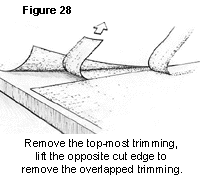
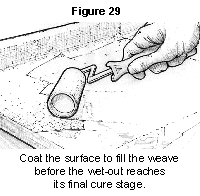
The result should be a near perfect butt joint, eliminating
double cloth thickness. A lapped joint is stronger than a butt joint, so if appearance is
not important, you may want to leave the overlap and fair in the unevenness after coating.
- Coat the surface to fill the weave before the wet-out
reaches its final cure stage (Figure 29). Follow the procedures for final coating
in the next section. It will take two or three coats to completely fill the weave of the
cloth and to allow for a final sanding that will not affect the cloth.
Wet method
An alternative is to apply the fabric or tape to a surface
coated with wet epoxy. As mentioned, this is not the preferred method, especially with
large pieces of cloth, because of the difficulty removing wrinkles or adjusting the
position of the cloth as it is being wet out. However, you may come across situations when
this method may be useful or necessary.
- Prepare the surface for bonding. Pre-fit and trim the cloth
to size. Roll the cloth neatly so that it may be conveniently rolled back into position
later.
- Roll a heavy coat of epoxy on the surface.
- Unroll the glass cloth over the wet epoxy and position it.
Surface tension will hold most cloth in position. If you are applying the cloth vertically
or overhead, you may want to thicken the epoxy slightly with filler, then wait until it
becomes sticky. Work out wrinkles by lifting the edge of the cloth and smoothing from the
center with your gloved hand or a squeegee.
- Apply a second coat of epoxy with a foam roller. Apply
enough epoxy to thoroughly wet out the cloth.
- Remove the excess epoxy with a squeegee, using long
overlapping strokes. The cloth should appear consistently transparent with a smooth cloth
texture.
- Follow steps 7, 8 and 9 under the dry method to finish the
procedure.
Any remaining irregularities or transitions between cloth
and substrate can be faired by using an epoxy/filler fairing compound if the surface is to
be painted. Any additional fairing done after the final coating should receive several
additional coats over the faired area.
Note: A third alternative for more experienced users is a
variation of both methods. Apply the fabric after a wet out coat has reached an initial
cure. Follow the first three steps of the Wet Method, but wait until the epoxy cures dry
to the touch before positioning the fabric and continuing with Step 3 of the Dry Method.
Apply the fabric before the first coat reaches its final cure phase.
Tips
Clear Wood Finishes
(stripper canoes, etc.) An alternative wet out method is to
lay the epoxy onto the fabric with a short-bristled bush. Dip the brush in the epoxy and
lay the epoxy on the surface with a light even stroke. Don’t force the epoxy into the
cloth, which may trap air in the fabric and show through the clear finish. Apply enough
epoxy to saturate the fabric and the wood below. After several minutes, lay on additional
epoxy to dry (white) areas. If epoxy appears milky due to high humidity or over-working,
warm the surface by passing a heat gun or hair dryer over the surface. Use low heat to
avoid out-gassing. Be sure to use 207 Hardener for clear finishes.
The object of barrier coating is to build up an epoxy
coating that provides an effective moisture barrier and a smooth base for final finishing.
Apply a minimum of two coats of WEST SYSTEM epoxy for an
effective moisture barrier. Apply three coats if sanding is to be done. Moisture
protection will increase with additional coats, up to six coats or about a 20-mil
thickness. Additives or pigments should not be added to the first coat. Mixing thinners
with WEST SYSTEM epoxy is not recommended.
Disposable, thin urethane foam rollers, such as WEST SYSTEM
800 Roller Covers, allow you greater control over film thickness, are less likely to cause
the epoxy to exotherm and leave less stipple than thicker roller covers. Cut the covers
into narrower widths to reach difficult areas or for long narrow surfaces like stringers.
Complete all fairing and cloth application before beginning
the final coating. Allow the temperature of porous surfaces to stabilize before coating.
Otherwise, as the material warms up, air within the porous material may expand and pass
from the material (out-gassing) through the coating and leave bubbles in the cured
coating.
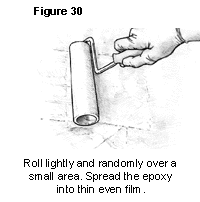
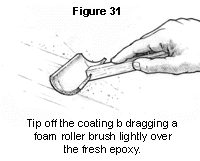
- Prepare the surface for.
- Mix only as much resin/hardener as you can apply during the
open time of the mixture. Pour the mixture into a roller pan as soon as it is mixed
thoroughly.
- Load the roller with a moderate amount of the epoxy mixture.
Roll the excess out on the ramp part of the roller pan to get a uniform coating on the
roller.
- Roll lightly and randomly over an area approximately 2 ft x
2 ft to transfer the epoxy evenly over the area (Figure 30).
- As the roller dries out, increase pressure enough to spread
the epoxy into a thin even film. Increase the coverage area if necessary to spread the
film more thinly and evenly. The thinner the film, the easier it is to keep it even and
avoid runs or sags in each coat.
- Finish the area with long, light, even strokes to reduce
roller marks. Overlap the previously coated area to blend both areas together.
- Coat as many of these small working areas as you can with
each batch. If a batch begins to thicken before it can be applied, discard it and mix a
fresh, smaller batch.
- Tip off the coating by dragging a foam roller brush lightly
over the fresh epoxy in long, even, overlapping strokes after each batch is applied. Use
enough pressure to smooth the stipple, but not enough to remove any of the coating (Figure
31). Alternate the direction in which each coat is tipped off, 1st coat vertical, 2nd
coat horizontal, 3rd coat vertical, etc. A WEST SYSTEM 800 Roller Cover can be cut into
segments to make a tipping brush.
Recoating
Apply second and subsequent coats of epoxy following the
same procedures. Make sure the previous coat has cured firmly enough to support the weight
of the next coat. To avoid sanding between coats, apply all of the coats in the same day.
After the final coat has cured overnight, wash and sand it to prepare for the final finish.
Proper finishing techniques will not only add beauty to
your efforts, but will also protect your work from ultraviolet light, which will break
down epoxy over time. The most common methods of finishing are painting or varnishing.
These coating systems protect the epoxy from ultraviolet light and require proper
preparation of the surface before application.
Preparation for the final finish is just as important as it
is for recoating with epoxy. The surface must first be clean, dry and sanded.

- Allow the final epoxy coat to cure thoroughly.
- Wash the surface with a Scotch-brite™ pad and water to
remove amine blush. Dry with paper towels.
- Sand to a smooth finish (Figure 32). If there are
runs or sags, begin sanding with 80-grit paper to remove the highest areas. Sand until the
surface feels and looks fair. Complete sanding with the appropriate grit for the type of
coating to be applied—check coating instructions. Paint adhesion relies on the
mechanical grip of the paint keying into the sanding scratches in the epoxy's surface. If
a high-build or filling primer is to be applied, 80–100 grit is usually sufficient.
120–180 grit may be adequate for primers and high-solids coatings. Finishing with
220–400 grit paper will result in a high-gloss finish for most paints or varnishes.
Grits finer than this may not provide enough tooth for good adhesion. Many people prefer
wet sanding because it reduces sanding dust and it will allow you to skip Step 2.
- After you are satisfied with the texture and fairness of the
surface, rinse the surface with fresh water. Rinse water should sheet evenly without
beading or fisheyeing. If rinse water beads up (a sign of contamination), wipe the area
with solvent and dry with a paper towel, then wet sand again until beading is eliminated.
Proceed with your final coating after the surface has dried
thoroughly. To reduce the possibility of contamination, it is a good idea to begin coating
within 24 hours of the final sanding. Follow all of the instructions from the coating
system's manufacturer. A good trick used by professionals, is to make a test panel to
evaluate the degree of surface preparation required and the compatibility of the finish
system.
The function of a finish coating like paint or varnish over
an epoxy barrier coat, is to decorate the surface and protect the epoxy from sunlight. In
doing so, the finish coating extends the life of the epoxy moisture barrier, which, in
turn provides a stable base that extends the life of the finish coating. Together the two
form a protective system far more durable than either coating by itself.
Protection from sunlight is a primary consideration in the
selection of a finish coating. Long term UV (ultraviolet) protection of the barrier coat
depends on how well the finish coating itself resists UV and keeps its pigments, or its
shield of UV filters on the surface of the epoxy barrier coat. A high gloss finish
reflects a higher proportion of the light hitting the surface than a dull surface. All
other thing being equal, a white (especially a glossy white) coating will last the
longest.
Most types of coatings are compatible with epoxy.
Thoroughly cured epoxy is an almost completely inert hard plastic. This means most paint
solvents will not soften, swell or react with it. However, it is still a good idea to
build a test panel to assure coating compatibility.
Coating types
Latex paints are compatible with epoxy and they do an
adequate job of protecting the epoxy barrier from UV radiation. In many architectural
applications latex paint may be the most suitable coating to use. Their durability is
limited.
Alkyd finishes—enamel, alkyd enamel, marine
enamel, acrylic enamel, alkyd modified epoxy, traditional varnish and spar
varnish—offer ease of application, low cost, low toxicity, and easy availability.
Their disadvantages are low UV resistance and low abrasion resistance.
One-part polyurethanes offer easy application,
cleanup and better properties than alkyds. They are also more expensive and some may be
incompatible with amine cure epoxy systems such as WEST SYSTEM epoxy, although 207
Hardener may offer better compatibility. Test first.
Epoxy paints are available in one-part and two-part
versions. Two-part epoxies offer many characteristics similar to the higher performance
polyurethanes. They are durable and chemical resistant, but offer limited UV protection
compared to the linear polyurethanes.
Two-part linear polyurethane (LP) paints offer the
most durable protection available. LP’s are available as pigmented or clear coatings
and offer excellent UV protection, gloss retention, abrasion resistance, plus
compatibility with epoxy. However, compared to other types of coatings, they are
expensive, require more skill to apply and present a greater health hazard, especially
when sprayed.
Bottom paints are available in a variety of
formulations. Most bottom paint systems are compatible with epoxy and can be applied
directly over a prepared epoxy barrier coat. If you are unsure of compatibility or have
curing or adhesion problems with a specific bottom paint, use only a primer recommended
for that bottom paint over the barrier coat. Follow the recommendations given for
preparation of fiberglass surfaces. Other paints, including marine LP's and primers, are
not recommended for use below the waterline.
Primers are usually not needed to help a paint film
bond to epoxy, although interfacing primers may be required with some specialized bottom
paints and high-build primers are useful for hiding scratches or flaws in the substrate.
If the instructions on your paint or varnish recommend a specially primed surface, follow
the recommendations given for fiberglass preparation. Self-etching primers do not work
well on an epoxy coating because of epoxy's chemical resistance.
Polyester gelcoat is a pigmented version of the
resin used to build fiberglass boats and other products. Gelcoat is sprayed into a mold
before the glass fabric and resin are applied to provide a smooth pre-finished surface
when the part is removed from the mold. It is not often used as a post-production finish
coating, but it can be applied over epoxy and is useful in some repair situations.
Refer to 002-550 Fiberglass Boat Repair and Maintenance, published by Gougeon Brothers, for detailed information on
patching gelcoat over an epoxy repair.
Follow all instructions from the coating systems
manufacturer. It is a good idea to make a test panel to evaluate the degree of surface
preparation required, and the compatibility and handling characteristics of the finish
system.
Thinning epoxy
There are epoxy-based products specifically designed to
penetrate and reinforce rotted wood. These products, basically an epoxy thinned with
solvents, do a good job of penetrating wood. But the solvents compromise the strength and
moisture barrier properties of the epoxy. WEST SYSTEM epoxy can be thinned with solvents
for greater penetration, but not without the same compromise in strength and moisture
resistance. Acetone, toluene or MEK have been used to thin WEST SYSTEM epoxy and duplicate
these penetrating epoxies with about the same effectiveness. If you chose to thin the
epoxy, keep in mind that the strength and moisture protection of the epoxy are lost in
proportion to the amount of solvent added.
There is a better solution to get good penetration without
losing strength or moisture resistance. We recommend moderate heating of the repair area
and the epoxy with a heat gun or heat lamp. The epoxy will have a lower viscosity and
penetrate more deeply when it is warmed and contacts the warmed wood cavities and pores.
Although the working life of the epoxy will be considerable shortened, slower hardeners
(206, 207, 209) will have a longer working life and should penetrate more than 205
Hardener before they begin to gel. When the epoxy cures it will retain all of its strength
and effectiveness as a moisture barrier, which we feel more than offsets any advantages
gained by adding solvents to the epoxy.
Removing epoxy
Removing uncured or non-curing epoxy. Uncured epoxy is
removed as you would spilled resin. Scrape as much material as you can from the surface
using a stiff metal or plastic scraper—warm the epoxy to lower its viscosity. Clean
the residue with lacquer thinner, acetone, or alcohol. Follow safety warnings on solvents,
and provide adequate ventilation. After recoating wood surfaces with epoxy, it's a good
idea to brush the wet epoxy (in the direction of the grain) with a wire brush to improve
adhesion. Allow solvents to dry before recoating.
Removing fiberglass cloth applied with epoxy.
Use a heat gun to heat and soften the epoxy. Start in a
small area a near a corner or edge. Apply heat until you can slip a putty knife or chisel
under the cloth (about 200°F). Grab the edge with a pair of pliers and pull up on the
cloth while heating just ahead of the separation. On large areas, use a utility knife to
score the glass and remove in narrower strips. Resulting surface texture may be coated or
remaining epoxy may be removed as follows.
Removing cured epoxy coating.
Use a heat gun to soften the epoxy (200°F). Heat a small
area and use a paint or cabinet scraper to remove the bulk of the coating. Sand the
surface to remove the remaining material. Provide ventilation when heating epoxy.
 1. Liquid—Open time
1. Liquid—Open time  Whether the
resin/hardener mixture is applied as a coating or modified with fillers or additives,
observing the following procedures will assure a controlled and thorough chemical
transition to a high-strength epoxy solid.
Whether the
resin/hardener mixture is applied as a coating or modified with fillers or additives,
observing the following procedures will assure a controlled and thorough chemical
transition to a high-strength epoxy solid. Pump one full pump stroke of
resin for each one full pump stroke of hardener. Depress each pump head fully and
allow the head to come completely back to the top before beginning the next stroke.
Partial strokes will give the wrong ratio. Read the pump instructions before using pumps.
Pump one full pump stroke of
resin for each one full pump stroke of hardener. Depress each pump head fully and
allow the head to come completely back to the top before beginning the next stroke.
Partial strokes will give the wrong ratio. Read the pump instructions before using pumps. To assure
thorough mixing, scrape the sides and bottom of the pot as you mix. Use the flat end of
the mixing stick to reach the inside corner of the pot. If you are using a power mixer,
occasionally scrape the sides and corners of the mixing pot while mixing.
To assure
thorough mixing, scrape the sides and bottom of the pot as you mix. Use the flat end of
the mixing stick to reach the inside corner of the pot. If you are using a power mixer,
occasionally scrape the sides and corners of the mixing pot while mixing.  For maximum strength, add only enough filler to completely bridge
gaps between surface without sagging or running out of the joint or gap. A small amount
should squeeze out of joints when clamped. For thick mixtures, don't fill the mixing cup
more than 1/3 full of epoxy before adding filler. When making fairing compounds, stir in
as much 407 or 410 as you can blend in smoothly—for easy sanding, the thicker the
better. Be sure all of the filler is thoroughly blended before the mixture is applied.
For maximum strength, add only enough filler to completely bridge
gaps between surface without sagging or running out of the joint or gap. A small amount
should squeeze out of joints when clamped. For thick mixtures, don't fill the mixing cup
more than 1/3 full of epoxy before adding filler. When making fairing compounds, stir in
as much 407 or 410 as you can blend in smoothly—for easy sanding, the thicker the
better. Be sure all of the filler is thoroughly blended before the mixture is applied.





























